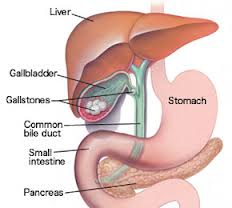
What is Gall Stone or Gall Bladder Stone? How to manage it? What are the precautions to be taken? What are the signs and symptoms? What is the cause of this disease? How to treat it? How can homeopathy help you? All of this answered, in this post and of course our doctors always there to help you. Just fill in your details in the form down below and we will answer all your questions for FREE!

What are Gallstones?
Gallstones or cholelithiasis are concretions usually made of bile cholesterol and bilirubin in the gallbladder. There can be one large gallstone or hundreds of tiny stones or both small and large stones.
What are the risk factors of Gall Bladder Stones?
Gallstones are associated with:
• Female gender
• Obesity
• Birth control pills/Hormone Replacement Therapy
• Pregnancy
• Increasing age
• Rapid weight loss
• Low HDL cholesterol
What are the Causes of Gall bladder stone?
• In certain conditions, the liver makes bilirubin in large amount e.g.in blood disease (chronic hemolytic anemia) or liver disease (biliary tract infection) that leads to stone formation.
• The gallbladder not empty completely due to poor muscle tone
What are the Signs and Symptoms of Gall bladder stone?
Gallstones may remain asymptomatic for years, these are called silent stones. When the size of gallstones increases more than 8 mm. symptoms start appearing.
• Constant severe pain in the upper right side of the abdomen lasting for several hours frequently at night.
• Pain radiates to right shoulder or back. Pain starts after the fatty or greasy meal.
• Nausea and vomiting
• Fever
• Indigestion, bloating, heartburn
• Jaundice (yellowish color of your skin or whites of your eye)
How to detect Gall bladder stone?
Your doctor can use your medical history, a physical examination, and certain lab and imaging test to diagnose gallstones:
• Blood test
• Ultrasound
• CT scan
• Cholescintigraphy
• Endoscopic ultrasound
• Endoscopic retrograde cholangiopancreatography
What’s the treatment of gall stones?
If patient has symptoms of gallstones then surgical removal of the gallbladder is the best option.
What are the problems that can occur after gallbladder removal?
Gall bladder stores bile which helps with the digestion of fat and its transfer from the intestine into the body. So after gallbladder removal avoids fatty, greasy, processed and sugary food as it can lead to gas, bloating and diarrhea.
What happens if gallstones left untreated?
Untreated gallstones can be life threatening, especially if gallbladder gets infected or pancreas gets inflamed.
What is the dietary management of Gallbladder stone?
• Avoid Non-Vegetarian diet
• Avoid fried food
• Avoid milk and milk products except for cheese.
• Oils should be restricted in the diet.
• Low cholesterol and low saturated fat oils are recommended.
What is the prognosis of Gallbladder stone?
Symptoms of gallstones do not return after surgery.
What is the Differential diagnosis of Gallbladder stone?
• Cholecystitis
• Bile duct tumors.
• Gallbladder cancer.
• Gastroenteritis.
• Pancreatic cancer.
• Acute pancreatitis.
• Gastric and peptic ulcers.
• Bile duct strictures.
• Appendicitis.
What are the commonly indicated Homeopathic remedies for Gall Bladder stones?
– Chelidonium majus
– Dioscorea
– Calcarea carbonica
– Lycopodium
– Cinchona officinalis
For more information, you can visit WebMD and eMedicine.
We have a strong web presence all across the globe with patients in major countries like United States, Australia, United Arab Emirates, Canada, United Kingdom, most European countries, & even smaller counties like Uganda, Nepal, Bangladesh and many more.
We have a very efficient team of doctors which includes the right combination of highly experienced doctors and the doctors of the new age.
Our main aim is to make the patient comfortable so that the case can be taken with ease and the patient be treated properly.
** The text on this website is sourced from websites like emedicine and/or other verified material by government agencies around the globe along with valuable inputs and additions by our team. The content of this page is proofread and updated by the team of doctors, every once in a while, to provide the most accurate information.